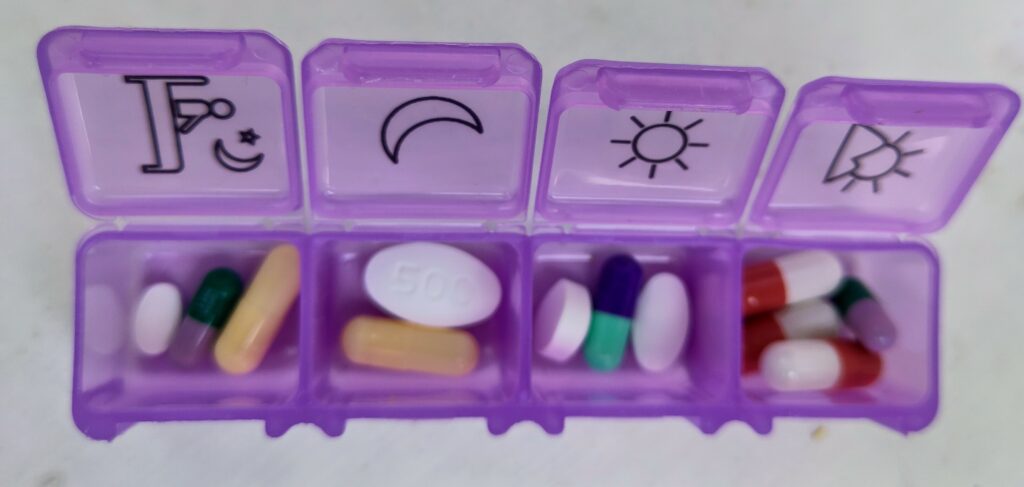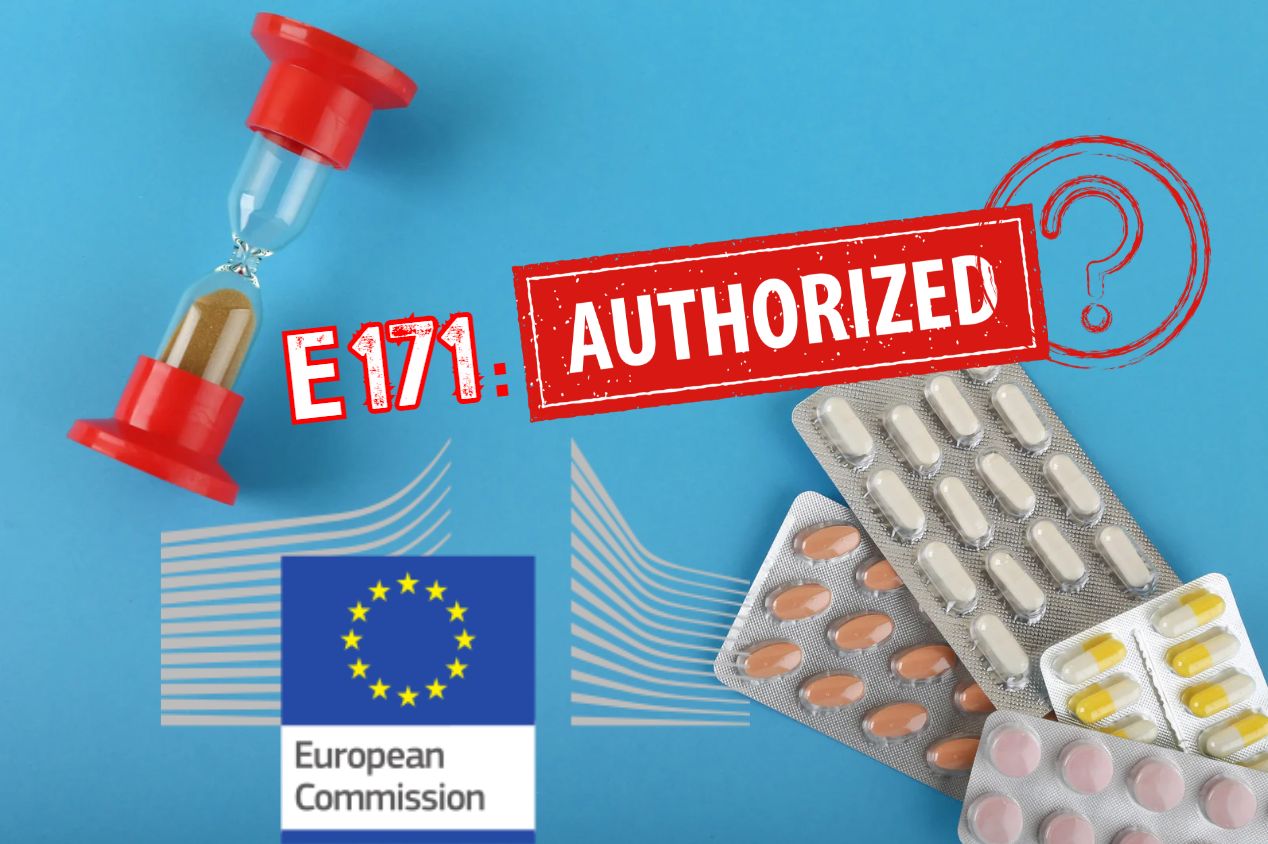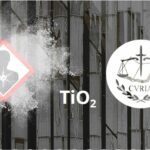
E171 in pharmaceuticals: when will the European Commission end its silence?
The European Commission’s decision on whether or not to extend the authorization of titanium dioxide (E171) in medicinal products was due by February 7. But four months have gone by… and still no movement on the horizon. This white colorant, banned as a food additive several years ago, is nonetheless still widely used as an excipient in many medicines.
The problem? Scientific studies point to numerous potential toxic effects.
AVICENN and Sylvie G., who suffers from Crohn’s disease, ask the European Commission to publish its decision and respect the principles of precaution and protection of human health. If no response is received within two months, an action for failure to act will be brought before the European Court of Justice. Because, unfortunately, patients cannot be expected to remain patient indefinitely.
Since 2022, the fate of E171 in medicines has been on hold
In early 2022, at the same time as it banned the additive E171 in food1following EFSA’s opinion acknowledging that the safety of E171 could not be established, cf. Titanium dioxide: E171 no longer considered safe when used as a food additive, EFSA, May 6, 2021 ; see also our factsheet The ban on TiO2 (E171) in food, AVICENN @VeilleNanos for more details, the European Commission had made a firm commitment: to decide, by February 2025, on the fate of E171 in medicines. Why wait three years? To give pharmaceutical laboratories time to make “ any possible efforts to accelerate the research and development of alternatives” to replace this very common excipient in medicines2Cf. recitals 14 to 18 and article 3 of European Regulation 2022/63, European Commission, January 2022: “The Commission is committed to review the necessity to maintain titanium dioxide (E 171) or otherwise delete it from the Union list of food additives for exclusive use as a colour in medicinal products within three years after the date of entering into force of this Regulation*”.. It’s true that a recipe for canned blanquette de veau, M&M’s or Têtes brûlées3Following the revelation by Agir pour l’Environnement of the presence of titanium dioxide in nanoparticulate form in these three products containing E171, the brands withdrew E171 from their recipes even before its formal ban in 2020. See for example:
– Une ONG dénonce la présence de nanoparticules dans des produits alimentaires préparés, AllôDocteurs, June 15, 2016
– Des centaines de bonbons contiennent du E171, un additif suspecté d’être cancérigène, TF1, October 28, 2016
– Verquin stoppe l’usage de dioxyde de titane dans ses bonbons, Les Echos, January 26, 2017
– La production française de M&M’s se fera sans dioxyde de titane, L’Info Durable, December 13, 2018 can be changed without having to go through the lengthy and costly marketing authorization review process to which drugs are subject.
The problem? Numerous potentially toxic effects
While it’s conceivable that laboratories could be given several years to reformulate their drugs, the wait-and-see attitude is no longer appropriate. The first warnings about E171 in drugs go back more than fifteen years now4See for example Titanium dioxide nanoparticles induce DNA damage and genetic instability in vivo in mice, Trouiller et al, Cancer Research, 69(22), 2009; Interaction Between Nano-Anatase TiO2 and Liver DNA from Mice In Vivo, Li, N et al, Nanoscale Res Lett, 5, 108, 2010; … and, as early as 2017, Que Choisir called for a ban “if the slightest doubt remains as to the safety of this compound”5Colorant E171 : Les médicaments aussi!, Que Choisir, February 4, 2017. However, in 2021, the European Food Safety Agency (EFSA) confirmed the existence of observations highlighting possible harmful effects: inflammation and altered immunity6immunotoxicity, reproduction7reprotoxicity and neurodevelopment8 neurotoxicity potentially linked to E171 and/or the titanium dioxide nanoparticles it may contain, as well as risks of DNA damage 9genotoxicity, even at low doses10Scientific opinion on the safety assessment of titanium dioxide as a food additive (E171), EFSA, 2021.
Since then, numerous scientific articles have been published, extending the list of publications11See the list of recent publications on adverse effects associated with ingestion of TiO2 or E171 compiled by AVICENN and our fact sheet on veillenanos.fr on Risks associated with ingestion of titanium dioxide nanoparticles reporting adverse effects associated with titanium dioxide ingestion – including risks of promoting type 2 diabetes or obesity.
In an article we relayed in March 202312Nanos in medicines and health products: recommendations for a better framework, AVICENN @VeilleNanos, March 2023, the Scientific Advisory Board of the French National Agency for the Safety of Medicines (ANSM) had in turn indicated that “the interest of nanoscale excipients (…) must be analyzed considering the potential risks and uncertainties related to the nanoscale”.
More than 6,000 medicines affected, each containing around 1.5 mg of E171
For their part, in a very recently published article13Cf. Exposure assessment of titanium dioxide via drugs available on the French market: A nationwide descriptive study, Cairat M, Huybrechts I, Fournier A, Therapies, 79(6): 718-729, November – December 2024, three researchers from INSERM and/or the International Agency for Research on Cancer (IARC) identified more than 6,500 pharmaceutical specialties containing E171 on the French market between 2001 and 2020 (i.e. 38% of specialties), mainly in film-coated or coated tablets, and softgels and capsules.
According to their estimates, the median amount of TiO2 is around 1.5 mg per drug. On average, women are slightly more exposed than men (1.81 mg per day vs. 1.54 mg per day) in the under-60 age group, and people aged 60 and over are exposed to much higher quantities of TiO2 (4 mg per day) than the under-60 age group.
This work, particularly useful for objectively quantifying the exposure of the French population, needs to be supplemented by more specific zooms. Behind this anonymous, globalized data, there is a wide disparity in exposure and, above all, more vulnerable human beings who suffer a double penalty: because of their chronic pathologies, which require them to take medication daily for years on end, they are more exposed than the rest of the population to E171 and its side effects.
At the end of 2022, following the publication of our Search for nanos in everyday products reporting the presence of titanium dioxide nanoparticles in the anticoagulant Xarelto14Searching for nanos in every day products, AVICENN @VeilleNanos, December 2022; previously, other tests, including those conducted by Que Choisir* and 60 millions de consommateurs**, had pointed to the presence of E171 and/or titanium dioxide nanoparticles in other medicines:
* Colorant E171 : Les médicaments aussi!, Que Choisir, February 4, 2017
** Médicaments : des nanos dans l’Efferalgan et le Nurofen, 60 Millions de consommateurs, March 22, 2018, AVICENN received for example an e-mail from Alain J., aged 66, who had to ingest more than 7 tablets containing E171 every day – an estimated daily intake of around 11 mg15His e-mail said:“Treated for heart problems, I take atenolol (Tenormin), amlodipine and atorvastatin for cholesterol: these 3 drugs contain E171 as an excipient. Still for my heart, I take Kardegic 75, which weakens the blood vessels and causes haemorrhoids, which I treat with Daflon, also containing E171.
Unfortunately suffering from prostatitis, I take either Permixon or Tadenan, 2 tablets a day, also containing E171…
When I can’t sleep, I take Zopiclone, which contains the same excipient, and if I want to lighten things up by taking Euphytose, I’m faced with the same problem…(…)
In short, I feel that the cumulative effect is not being taken seriously by either the laboratories or the Ministry of Health, while confectioners have excluded this product from their preparations. (…) That’s it, in case my voice could be heard a little, and you could pass it on.” Since then, Alain J. has had to increase his intake of E171 because of new skeleto-muscular and osteoarthritis problems..
More recently, we spoke with Sylvie G., under 60, who suffers from chronic pathologies: Crohn’s disease (a digestive autoimmune disease) and associated anxiety disorders, also linked to burnout, have forced her to ingest medication every day for the past forty years (currently up to a dozen tablets a day16Her prescriptions are as follows:
– Racecadotril 100 mg (Tiorfan), an anti-diarrheal: 3 per day – Budesonide 3 mg (Antecor), a glucocorticoid: 3 per day
– Loperamide 2 mg (Imodium), an anti-diarrheal: up to 6 per day
– Fluoxetine 20 mg (Prozac), 1 per day
– Ursodesoxycholic acid 500 mg (Delursan), 1 per day) containing E171 likely to aggravate her pathology and associated anxiety disorders17See in particular:
– Perinatal foodborne titanium dioxide exposure-mediated dysbiosis predisposes mice to develop colitis through life, Carlé C et al, Particle and Fibre Toxicology, (20), 45, 2023
– TiO2 nanoparticles abrogate the protective effect of the Crohn’s disease-associated variation within the PTPN22 gene locus, Schwarzfischer M et al, Gut, 72(6):1101-1114, 2023
– A review of research on the impact of E171/TiO2 NPs on the digestive tract, Baranowska-Wójcik E et al., Biology, 72: 126988, 2022
– Oral exposure to Ag or TiO2 nanoparticles disrupted gut transcriptome and microbiota in a mouse model of ulcerative colitis, Wang et al, Food and Chemical Toxicology, 169(11):113368, 2022
– Titanium dioxide particles from the diet: involvement in the genesis of inflammatory bowel diseases and colorectal cancer, Barreau et al, Particle and Fibre Toxicology, 18(26), 2021
– TiO2 – do we have to worry about it? One of the important aetiological factors in inflammatory bowel disease , Jarmakiewicz-Czaja S et al, Prz Gastroenterol, 4;16(2):106-110, 2021
– …. On the basis of 1.5 mg per tablet or capsule, the daily dose of E171 she ingests therefore climbs to 18 mg per day… ten times higher than the average estimated by IARC researchers for the general population.

What about the risks for people with other digestive pathologies (such as ulcerative colitis), especially for children and pregnant women or those planning to become pregnant? What about immunocompromised patients?
Over 18,000 signatures in favor of banning E171 in French medicines
At the end of March 2025, an anonymous ‘angry citizen’ launched a petition on the MesOpinions.com platform. Entitled ‘Titanium dioxide must be banned from medicines‘, the petition gathered thousands of signatures in just a few hours, and today boasts over 18,000 signatures, obtained without the aid of advertising. AVICENN contacted the MesOpinions.com platform to ask to be put in touch with the author of the petition, without success. Is such an individual initiative likely to succeed if it remains isolated? Given the European Commission’s silence, it’s doubtful. The latter seems to be bogged down in a decision-making process subject to strong pressure from the pharmaceutical laboratories.
Three years and four months after the launch of the European countdown, still nothing.
In 2021, a report from the European Medicines Agency (EMA)18Final feedback from European Medicine Agency (EMA) to the EU Commission request to evaluate the impact of the removal of titanium dioxide from the list of authorised food additives on medicinal products, EMA, September 2021 ; see also on this subject the article Interdiction du dioxyde de titane – Coup de frein de l’Agence européenne des médicaments, Que Choisir, 2021 had relayed the arguments and figures of pharmaceutical companies19Use of titanium dioxide as excipient in human medicines – Industry feedback to QWP experts/EMA questions, AESGP, EFPIA , Medicines for Europe, July 2021, estimating that seven to twelve years would be needed to remove this excipient from medicines in the European Union. In April 2024, the EMA finalized and sent a new report to the European Commission, but did not make it public20AVICENN requested it on several occasions, without success. A 569-page document21Use of titanium dioxide as excipient in human and veterinary medicines and identification of alternatives, Industry feedback to GWP experts/EMA questions, EFPIA, TiO2 Alternatives Consortium, Medicines for Europe, AESGP, Animal Health Europe, Access Vetmed, IPEC Europe, EUCOPE, February 2024 sent to EMA by pharmaceutical companies in February 2024 reiterates this alleged need for a delay of seven to twelve years… as if the three years since 2021 had not taken place.
On March 17, AVICENN emailed the European Commission to find out when its decision would be published. DG Health replied three days later, assuring us that it is “working to ensure that all aspects related to this complex issue are thoroughly considered, and that the findings reflect the latest scientific and regulatory insights“, while pledging to “complete this process as promptly as possible”… with no further details on the timetable.
In June, still nothing.
Is the Commission waiting for the results of work funded by the titanium dioxide manufacturers’ federation (TDMA)? The latter recently pointed out that “the TiO2 industry continues to invest millions of euros in various scientific programs to confirm the safety of TiO2” 22Titanium Dioxide Manufacturers Association (TDMA) website, TDMA, February 2025. At the same time, less and less independent research is being funded on the risks associated with ingesting TiO2, due to a lack of public funding23INRAé, which had carried out important research on E171*, has stopped funding research on this additive… since it has been banned in food in France as of 2020 and the drugs sector does not fall within its field of expertise. A project was then funded in 2021 by the Crohn’s RCH France patient association. Another project funded by the Foundation for Medical Research (FRM) is still underway, but this is the exception that proves the rule: there is virtually no research funded in France on this crucial subject.
* Cf. Food additive E171: first findings of oral exposure to titanium dioxide nanoparticles, INRAE, January 2017; Nanoparticles of titanium dioxide: E171 crosses the placental barrier, INRAE, October 2020; Titanium dioxide: E171 first enters the blood via the mouth, INRAE, May 2023. .
The case is referred to the European Commission, and an action for failure to act is in prospect.
Seeing that the European Commission, four months to the day after the date of February 7 set by the regulation for the delivery of its decision24The three-year deadline set by the European Commission ran from the twentieth day following that of its publication in the Official Journal of the European Union of January 18, 2025, i.e. February 7, 2025, had still not published anything on E171 in medicinal products, AVICENN and Sylvie G. have officially contacted the European Commission and the European Ombudsman. Our request? That the Commission respect its commitments, as well as the principles of precaution25article 191 §2 of the Treaty on the Functioning of the European Union (TFEU) and the protection of human health26article 168 of the Treaty on the Functioning of the European Union (TFEU) enshrined in the Treaty on the Functioning of the European Union. If no response is received within two months, an action for failure to act will be brought before the General Court of the European Union.
NB: among the patients reading this article, those who have to take a heavy and chronic medication consisting of drugs containing E171 are obviously advised to continue their treatment.
→ For some pharmaceutical references, there are drugs with the same active substance but without E171: consult the public drug database27The composition is detailed towards the bottom of the 3rd tab entitled “notice”. or contact your pharmacy for more information..
PS: Following the publication of this article, other media have covered the issue raised by E171 in medicines:
- 60 millions de consommateurs on June 13,
- Que Choisir on June 14,
- Le Moniteur des pharmacies on June 17,
- 20 Minutes – Le Journal des Seniors, on June 17,
- MédiSite on June 20,
- France inter, Sud Ouest and Femme Actuelle on June 26,
- Marie-France on June 30,
- Lutte ouvrière on July 2,
- Le Monde on July 23.

Other nano-related news
Next nano events

- E-learning program: awareness-raising for personnel who come into contact with nanomaterials during research, formulation, production, maintenance, cleaning, upkeep, etc., as well as safety coordinators or engineers, facility managers, heads of laboratories where nanoparticles are handled.
- Organizers: INSTN Grenoble (CEA)
- On the program:
- 1 – Introduction, definition and characteristics of nanomaterials
- 2 – Toxicity of nanomaterials: the state of knowledge
- 3 – Metrology and characterization of nanomaterials
- 4 – Prevention and protection against nanomaterials in the workplace
- 5 – Quiz: assessment of learning outcomes
- The 2-hour course can be viewed for one month from the date of registration.
- Website: https://instn.cea.fr/…risques-lies-aux-nanomateriaux…
- Annual conference of the NaMasTE research group (Manufactured Nanomaterials, Toxicology, Ecotoxicology and Risks: towards controlled development)
- Dates: December 9 and 10, 2025
- Organizers: CNRS
- Website: https://namaste2025.sciencesconf.org
- 8th Congress of Occupational Medicine and Health (CNMST 2026)
- Theme 5: Emerging pathologies and risks, Mr Henri Bastos (ANSES), Pr Lynda Bensefa-Colas (AP-HP), Dr Catherine Nisse (CHU Lille)
- Website: www.medecine-sante-travail.com
Notes and references
- 1following EFSA’s opinion acknowledging that the safety of E171 could not be established, cf. Titanium dioxide: E171 no longer considered safe when used as a food additive, EFSA, May 6, 2021 ; see also our factsheet The ban on TiO2 (E171) in food, AVICENN @VeilleNanos for more details
- 2Cf. recitals 14 to 18 and article 3 of European Regulation 2022/63, European Commission, January 2022: “The Commission is committed to review the necessity to maintain titanium dioxide (E 171) or otherwise delete it from the Union list of food additives for exclusive use as a colour in medicinal products within three years after the date of entering into force of this Regulation*”.
- 3Following the revelation by Agir pour l’Environnement of the presence of titanium dioxide in nanoparticulate form in these three products containing E171, the brands withdrew E171 from their recipes even before its formal ban in 2020. See for example:
– Une ONG dénonce la présence de nanoparticules dans des produits alimentaires préparés, AllôDocteurs, June 15, 2016
– Des centaines de bonbons contiennent du E171, un additif suspecté d’être cancérigène, TF1, October 28, 2016
– Verquin stoppe l’usage de dioxyde de titane dans ses bonbons, Les Echos, January 26, 2017
– La production française de M&M’s se fera sans dioxyde de titane, L’Info Durable, December 13, 2018 - 4See for example Titanium dioxide nanoparticles induce DNA damage and genetic instability in vivo in mice, Trouiller et al, Cancer Research, 69(22), 2009; Interaction Between Nano-Anatase TiO2 and Liver DNA from Mice In Vivo, Li, N et al, Nanoscale Res Lett, 5, 108, 2010; …
- 5Colorant E171 : Les médicaments aussi!, Que Choisir, February 4, 2017
- 6immunotoxicity
- 7reprotoxicity
- 8neurotoxicity
- 9genotoxicity
- 10
- 11See the list of recent publications on adverse effects associated with ingestion of TiO2 or E171 compiled by AVICENN and our fact sheet on veillenanos.fr on Risks associated with ingestion of titanium dioxide nanoparticles
- 12Nanos in medicines and health products: recommendations for a better framework, AVICENN @VeilleNanos, March 2023
- 13Cf. Exposure assessment of titanium dioxide via drugs available on the French market: A nationwide descriptive study, Cairat M, Huybrechts I, Fournier A, Therapies, 79(6): 718-729, November – December 2024
- 14Searching for nanos in every day products, AVICENN @VeilleNanos, December 2022; previously, other tests, including those conducted by Que Choisir* and 60 millions de consommateurs**, had pointed to the presence of E171 and/or titanium dioxide nanoparticles in other medicines:
* Colorant E171 : Les médicaments aussi!, Que Choisir, February 4, 2017
** Médicaments : des nanos dans l’Efferalgan et le Nurofen, 60 Millions de consommateurs, March 22, 2018 - 15His e-mail said:“Treated for heart problems, I take atenolol (Tenormin), amlodipine and atorvastatin for cholesterol: these 3 drugs contain E171 as an excipient. Still for my heart, I take Kardegic 75, which weakens the blood vessels and causes haemorrhoids, which I treat with Daflon, also containing E171.
Unfortunately suffering from prostatitis, I take either Permixon or Tadenan, 2 tablets a day, also containing E171…
When I can’t sleep, I take Zopiclone, which contains the same excipient, and if I want to lighten things up by taking Euphytose, I’m faced with the same problem…(…)
In short, I feel that the cumulative effect is not being taken seriously by either the laboratories or the Ministry of Health, while confectioners have excluded this product from their preparations. (…) That’s it, in case my voice could be heard a little, and you could pass it on.” Since then, Alain J. has had to increase his intake of E171 because of new skeleto-muscular and osteoarthritis problems. - 16Her prescriptions are as follows:
– Racecadotril 100 mg (Tiorfan), an anti-diarrheal: 3 per day – Budesonide 3 mg (Antecor), a glucocorticoid: 3 per day
– Loperamide 2 mg (Imodium), an anti-diarrheal: up to 6 per day
– Fluoxetine 20 mg (Prozac), 1 per day
– Ursodesoxycholic acid 500 mg (Delursan), 1 per day - 17See in particular:
– Perinatal foodborne titanium dioxide exposure-mediated dysbiosis predisposes mice to develop colitis through life, Carlé C et al, Particle and Fibre Toxicology, (20), 45, 2023
– TiO2 nanoparticles abrogate the protective effect of the Crohn’s disease-associated variation within the PTPN22 gene locus, Schwarzfischer M et al, Gut, 72(6):1101-1114, 2023
– A review of research on the impact of E171/TiO2 NPs on the digestive tract, Baranowska-Wójcik E et al., Biology, 72: 126988, 2022
– Oral exposure to Ag or TiO2 nanoparticles disrupted gut transcriptome and microbiota in a mouse model of ulcerative colitis, Wang et al, Food and Chemical Toxicology, 169(11):113368, 2022
– Titanium dioxide particles from the diet: involvement in the genesis of inflammatory bowel diseases and colorectal cancer, Barreau et al, Particle and Fibre Toxicology, 18(26), 2021
– TiO2 – do we have to worry about it? One of the important aetiological factors in inflammatory bowel disease , Jarmakiewicz-Czaja S et al, Prz Gastroenterol, 4;16(2):106-110, 2021
– … - 18Final feedback from European Medicine Agency (EMA) to the EU Commission request to evaluate the impact of the removal of titanium dioxide from the list of authorised food additives on medicinal products, EMA, September 2021 ; see also on this subject the article Interdiction du dioxyde de titane – Coup de frein de l’Agence européenne des médicaments, Que Choisir, 2021
- 19Use of titanium dioxide as excipient in human medicines – Industry feedback to QWP experts/EMA questions, AESGP, EFPIA , Medicines for Europe, July 2021
- 20AVICENN requested it on several occasions, without success
- 21Use of titanium dioxide as excipient in human and veterinary medicines and identification of alternatives, Industry feedback to GWP experts/EMA questions, EFPIA, TiO2 Alternatives Consortium, Medicines for Europe, AESGP, Animal Health Europe, Access Vetmed, IPEC Europe, EUCOPE, February 2024
- 22Titanium Dioxide Manufacturers Association (TDMA) website, TDMA, February 2025
- 23INRAé, which had carried out important research on E171*, has stopped funding research on this additive… since it has been banned in food in France as of 2020 and the drugs sector does not fall within its field of expertise. A project was then funded in 2021 by the Crohn’s RCH France patient association. Another project funded by the Foundation for Medical Research (FRM) is still underway, but this is the exception that proves the rule: there is virtually no research funded in France on this crucial subject.
* Cf. Food additive E171: first findings of oral exposure to titanium dioxide nanoparticles, INRAE, January 2017; Nanoparticles of titanium dioxide: E171 crosses the placental barrier, INRAE, October 2020; Titanium dioxide: E171 first enters the blood via the mouth, INRAE, May 2023. - 24The three-year deadline set by the European Commission ran from the twentieth day following that of its publication in the Official Journal of the European Union of January 18, 2025, i.e. February 7, 2025
- 25article 191 §2 of the Treaty on the Functioning of the European Union (TFEU)
- 26article 168 of the Treaty on the Functioning of the European Union (TFEU)
- 27The composition is detailed towards the bottom of the 3rd tab entitled “notice”.




